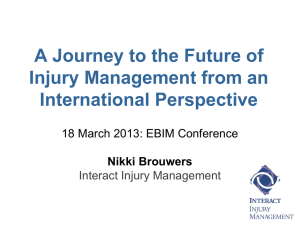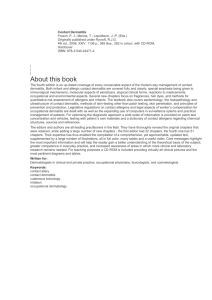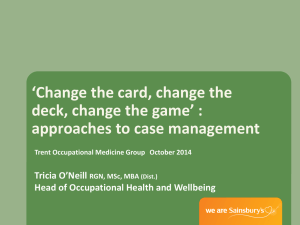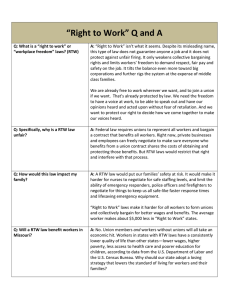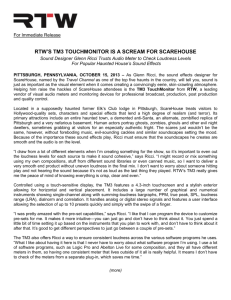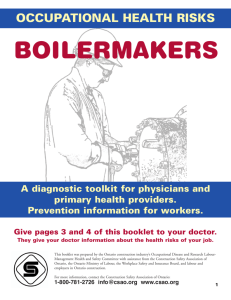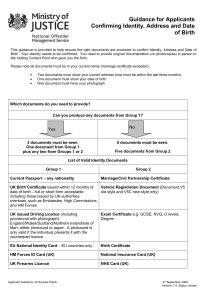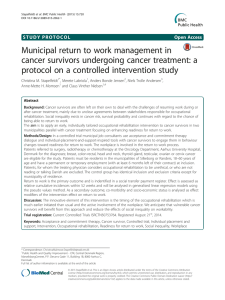Case Study Housekeeping Worker – Case Study
advertisement
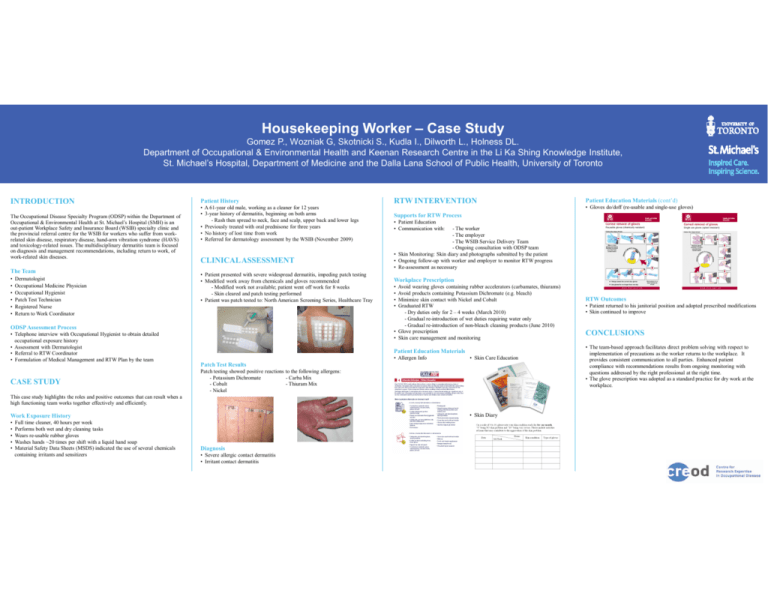
Housekeeping Worker – Case Study Gomez P., Wozniak G, Skotnicki S., Kudla I., Dilworth L., Holness DL. Department of Occupational & Environmental Health and Keenan Research Centre in the Li Ka Shing Knowledge Institute, St. Michael’s Hospital, Department of Medicine and the Dalla Lana School of Public Health, University of Toronto INTRODUCTION The Occupational Disease Specialty Program (ODSP) within the Department of Occupational & Environmental Health at St. Michael’s Hospital (SMH) is an out-patient Workplace Safety and Insurance Board (WSIB) specialty clinic and the provincial referral centre for the WSIB for workers who suffer from workrelated skin disease, respiratory disease, hand-arm vibration syndrome (HAVS) and toxicology-related issues. The multidisciplinary dermatitis team is focused on diagnosis and management recommendations, including return to work, of work-related skin diseases. The Team • • • • • • Dermatologist Occupational Medicine Physician Occupational Hygienist Patch Test Technician Registered Nurse Return to Work Coordinator Patient History • A 61-year old male, working as a cleaner for 12 years • 3-year history of dermatitis, beginning on both arms - Rash then spread to neck, face and scalp, upper back and lower legs • Previously treated with oral prednisone for three years • No history of lost time from work • Referred for dermatology assessment by the WSIB (November 2009) CLINICAL ASSESSMENT • Patient presented with severe widespread dermatitis, impeding patch testing • Modified work away from chemicals and gloves recommended - Modified work not available; patient went off work for 8 weeks - Skin cleared and patch testing performed • Patient was patch tested to: North American Screening Series, Healthcare Tray ODSP Assessment Process • Telephone interview with Occupational Hygienist to obtain detailed occupational exposure history • Assessment with Dermatologist • Referral to RTW Coordinator • Formulation of Medical Management and RTW Plan by the team CASE STUDY RTW INTERVENTION • Patient Education • Communication with: - The worker - The employer - The WSIB Service Delivery Team - Ongoing consultation with ODSP team • Skin Monitoring: Skin diary and photographs submitted by the patient • Ongoing follow-up with worker and employer to monitor RTW progress • Re-assessment as necessary Workplace Prescription • • • • Avoid wearing gloves containing rubber accelerators (carbamates, thiurams) Avoid products containing Potassium Dichromate (e.g. bleach) Minimize skin contact with Nickel and Cobalt Graduated RTW - Dry duties only for 2 – 4 weeks (March 2010) - Gradual re-introduction of wet duties requiring water only - Gradual re-introduction of non-bleach cleaning products (June 2010) • Glove prescription • Skin care management and monitoring • Allergen Info • Skin Care Education Patch Test Results Patch testing showed positive reactions to the following allergens: - Potassium Dichromate - Carba Mix - Cobalt - Thiuram Mix - Nickel This case study highlights the roles and positive outcomes that can result when a high functioning team works together effectively and efficiently. • • • • • Full time cleaner, 40 hours per week Performs both wet and dry cleaning tasks Wears re-usable rubber gloves Washes hands ~20 times per shift with a liquid hand soap Material Safety Data Sheets (MSDS) indicated the use of several chemicals containing irritants and sensitizers • Skin Diary Diagnosis • Severe allergic contact dermatitis • Irritant contact dermatitis • Gloves do/doff (re-usable and single-use gloves) Supports for RTW Process Patient Education Materials Work Exposure History Patient Education Materials (cont’d) RTW Outcomes • Patient returned to his janitorial position and adopted prescribed modifications • Skin continued to improve CONCLUSIONS • The team-based approach facilitates direct problem solving with respect to implementation of precautions as the worker returns to the workplace. It provides consistent communication to all parties. Enhanced patient compliance with recommendations results from ongoing monitoring with questions addressed by the right professional at the right time. • The glove prescription was adopted as a standard practice for dry work at the workplace.
